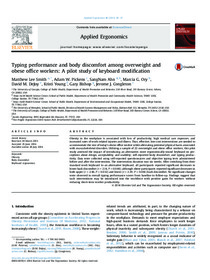Typing performance and body discomfort among overweight and obese office workers: a pilot study of keyboard modification

Lee Smith, Matthew ; Pickens, Adam W. ; Ahn, SangNam ; Ory, Marcia G. ; DeJoy, David M. ; Young, Kristi ; Bishop, Gary ; Congleton, Jerome J.
2015
46
Part A
30-37
design of equipment ; keyboard operations ; musculoskeletal diseases ; obesity ; office work
Ergonomics and work environment
http://dx.doi.org/10.1016/j.apergo.2014.06.004
English
Bibliogr.
"Obesity in the workplace is associated with loss of productivity, high medical care expenses, and increased rates of work-related injuries and illness. Thus, effective, low-cost interventions are needed to accommodate the size of today's obese office worker while alleviating potential physical harm associated with musculoskeletal disorders. Utilizing a sample of 22 overweight and obese office workers, this pilot study assessed the impact of introducing an alternative, more ergonomically-sound keyboard on perceptions about design, acceptability, and usability; self-reported body discomfort; and typing productivity. Data were collected using self-reported questionnaires and objective typing tests administered before and after the intervention. The intervention duration was six weeks. After switching from their standard work keyboard to an alternative keyboard, all participants reported significant decreases in lower back discomfort (t = 2.14, P = 0.044); although obese participants reported significant decreases in both upper (t = 2.46, P = 0.032) and lower (t = 2.39, P = 0.036) back discomfort. No significant changes were observed in overall typing performance scores from baseline to follow-up. Findings suggest that such interventions may be introduced into the workforce with positive gains for workers without reducing short-term worker productivity."
Digital
The ETUI is co-funded by the European Union. Views and opinions expressed are however those of the author(s) only and do not necessarily reflect those of the European Union or the ETUI.